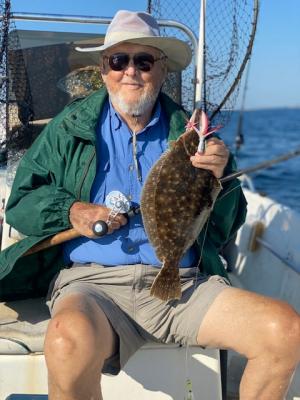A few weeks ago, I wrote an article about how lucky all of us are who live in the Cape Region. Last week, I had the opportunity to prove it to myself.
Barbara and I went to Freehold, N.J., to visit our son Roger for a few days, and just getting there on a Saturday was more of an adventure than I had anticipated. It was stop-and-go traffic all the way from the Broadkill River bridge on Route 1 to the Delaware Memorial Bridge. Traffic thinned out on 295 and was not too bad on 195 to Freehold.
Since I live at the beach, I have always avoided Route 1 on the weekends. Now I know why.
As you might expect, Roger and I spent the better part of one day fishing. Roger has a very good friend, Gene, who lent us his 18-foot skiff, and the weather was beautiful on Thursday morning.
We left the dock around 6:30 a.m. and headed out the Manasquan River to a series of reef sites in the ocean. The current was close to high slack, so the inlet was all but calm.
I set up with a top-bottom rig baited with spot I had saved from a surf-fishing trip the week before. Roger used a bucktail with a large Gulp! and a bare hook with a smaller Gulp! in nuclear chicken as a teaser.
My spot was attacked as soon as the 4-ounce sinker touched bottom. I missed the first few bites before coming tight on a very nice sea robin. Roger also missed a few hits before catching a short flounder.
When I say short flounder, this is New Jersey, where the regulations are quite different from in Delaware. Here you are allowed two summer flounder between 17 and 17.99 inches, and one summer flounder greater than 18 inches. That’s a total of three flounder. Just about every flounder Roger caught was 16 inches or just shy of the 17-inch mark.
Since everything I caught had wings, I decided to switch tactics and go with a bucktail and teaser. Tsunami makes it easy to do with their Jigging Rig with a Glass Minnow teaser. I just snapped my bucktail on the bottom, decorated it with a 5-inch Gulp! twister tail in green and put a smaller Gulp! tail in nuclear chicken on the glass minnow. I dropped that to the bottom and was quickly rewarded with a short flounder.
Roger kept moving the boat around using the tracks that Gene had left on the GPS to keep us over productive bottom. While the bottom was productive, it was only producing shorts.
At one stop, as my bucktail hit bottom and I tried to raise it up a few inches, it wouldn’t budge. Then it began to swim away with a definite purpose. While no one has ever accused me of being the brightest beacon on the beach, I deduced this as a large fish holding my bucktail. Roger came to the same conclusion and grabbed the landing net. After an exciting tussle, I was able to lead the fish to the net and Roger put it in the boat. A quick measure showed the flounder to be 22 inches, so we now had our one over 18 inches. All the previous flounder had hit the teaser, but this one took the larger bucktail.
With that fish in the cooler, we went back to short flounder and the occasional sea robin. Finally, Roger caught a 17-inch flounder and a 13-inch black sea bass.
When the current slowed, the fishing went with it and we headed back to the dock.
Manasquan Inlet was a zoo. Every boat was much larger than ours, and they all ran as fast as possible. Their wakes made for some interesting navigational situations, but Capt. Burnley handled them all with skill. Back at the dock, he demonstrated one of his other skills, fish cleaning. Fish cleaned, boat cleaned and we were on our way home in short order.
I would say there are 10 times the number of boats (if not more) running out of Manasquan Inlet than out of Indian River or Roosevelt Inlet, and the majority of those boats will not fit on a trailer. The Bogans run more big head boats out of here than we have in all of Delaware. Congestion is a way of life.
I have been fishing in New Jersey since I went to work for the Fisherman Magazine in 1973. I was not surprised by the crowded conditions, but it once again reminded me of how lucky I am to live in the Cape Region.
In the accompanying photo, I am not wearing my PFD. I simply forgot it.























































